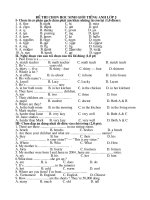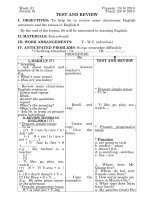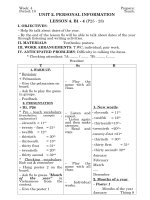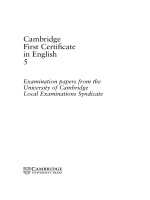ENGLISH 5- WEEK 4
Bạn đang xem bản rút gọn của tài liệu. Xem và tải ngay bản đầy đủ của tài liệu tại đây (137.98 KB, 13 trang )
<span class='text_page_counter'>(1)</span><div class='page_container' data-page=1>
<i><b>Date of preparation: 17/9/2017 Week </b></i>
<i><b>4</b></i>
<i><b> Period 11 </b></i>
<b> UNIT 2: I ALWAYS GET UP EARLY. HOW ABOUT YOU?</b>
<i><b> Lesson 3: Part 1-2-3</b></i>
<b>I. Objectives:</b>
<i><b>1.Knowledge: </b></i>
<i><b>• - pronounce two-syllable words with the stress on the first syllable: 'always, </b></i>
<i><b>2. Skills: </b></i>
- Develop Ps writing and listening skills
<i><b>3. Language focus:</b></i>
<b>- Vocabulary and structures: Review</b>
<i>• - Phonics stress on the first syllable: 'always, 'usually,'often and 'sometimes.</i>
<b>II. Teaching aids:</b>
<i>1. Teacher’s: student’s and teacher’s book, pictures, cassette.</i>
<i>2. Students’: books, notebooks, workbooks.</i>
<b>III. Teaching processes:</b>
<b>1. Class organzation:</b>
<b>Date of teaching</b> <b>Class</b> <b>Number of students</b>
<b>25/9/2012</b> <b>5C</b>
<b> 2.New lesson</b>
</div>
<span class='text_page_counter'>(2)</span><div class='page_container' data-page=2>
<b>II. New lesson:</b>
<i><b>1. Listen and repeat</b></i>
• Tell the class that they are going to practise saying
two-syllable words with the stress on the first two-syllable:
'always, 'usually, 'often and 'sometimes.
• Play the recording all the way through for pupils to listen
first. Play the recording again for them to repeat the
words and the sentences twice.
<i><b>2. Listen and circle. Then say aloud</b></i>
• - Tell the class that they are going to listen and circle
<i>a or b to complete the sentences.</i>
• Give them a few seconds to read the sentences in
silence before playing the recording for them to do
thetask.
• Get them to compare their answers in pairs before
checking as a class.
<b>Key: 1 a</b> <b>2 b</b> <b>3 a</b> <b>4 b</b>
<i><b>3. Let’s chant</b></i>
<i>• Tell the class that they are going to say the chant What </i>
<i>do you do in the morning? Havepupils</i>
read the chant and check their comprehension.
• Play the recording all the way through for them to
listen and follow in their books. Play it
againforthemtorepeatlinebyline.
• Puttheclassintotwogroupstopractisechantingthequestion
sandtheanswersrespectively.
• Havethempractisesayingthechantanddoactionsingroups.
• Invitetwogroupstothefrontoftheclasstosaythechantandd
- Listen to the
teacher
- Listen to the tape
- Listen and repeat in
choral, groups and
individual
- Listen to the
teacher
- Look at the books
and guess
- Listen and write
- Listen and check
- Read aloud
- Listen to the
teacher
</div>
<span class='text_page_counter'>(3)</span><div class='page_container' data-page=3>
oactions.Therestoftheclass claps along to therhythm.
<b>III. Consolidation</b>
- Summary the lesson
<b>IV. Homework</b>
- Do exercises in workbook, prepare the next period.
- Work in pairs
- The whole class
- Listen
- Remember
<b> Comment:</b>
<b>………</b>
<b>………</b>
<b>………</b>
<i><b>Date of preparation: 17/9/2017 Week 4</b></i>
<i><b> Period 12 </b></i>
<b> UNIT 2: I ALWAYS GET UP EARLY. HOW ABOUT YOU?</b>
<i><b> Lesson 3: Part 4-5-6-7</b></i>
<b>I. Objectives:</b>
<i><b>1. Knowledge: </b></i>
- By the end of the lesson, Ps will be able to use words and phrases related to the topic
Daily routines
<i><b>2. Skills: </b></i>
- Develop Ps writing and listening skills
<i><b>3. Language focus:</b></i>
</div>
<span class='text_page_counter'>(4)</span><div class='page_container' data-page=4>
<b>II. Teaching aids:</b>
<i>1. Teacher’s: student’s and teacher’s book, pictures, cassette.</i>
<i>2. Students’: books, notebooks, workbooks.</i>
<b>III. Teaching processes:</b>
<b>1. Class organzation:</b>
<b>Date of teaching</b> <b>Class</b> <b>Number of students</b>
<b>25/9/2012</b> <b>5D</b>
<b>25/9/2017</b> <b>5A</b>
<b>25/9/2017</b> <b>5C</b>
<b> 2.New lesson</b>
<b>Teacher’s activities</b> <b>Students’ activities</b>
<b>I.Warm up: Spend a few minutes having the class say the </b>
<i>chant What do you do in the morning?</i>
<b>II. New lesson:</b>
<i><b>4. Read and answer</b></i>
• Tell the class that they are going to read the text and
answer the questions.
<i>• Give them a few seconds to look at the picture and </i>
<i>ask: Who’s this? What’s she doing? What’s </i>
<i>shewatching?</i>
<i>• Explain the meanings of the new words: go </i>
<i>jogging,programme.</i>
• Set a time limit for them to read the text and do the
task independently. Monitor the activity and offer
help, ifnecessary.
• Have pupils compare their answers before checking as
a class.
<b>Key: 1Shegetsupearlyandusuallygoesjogging.</b>
- Read the chant
- Listen to the teacher
- Read the paragraph
- Individually
- Work in pairs
- Some Ps
</div>
<span class='text_page_counter'>(5)</span><div class='page_container' data-page=5>
<b>2</b>She usually does her homework. Then she
often plays badminton and sometimes
cooks dinner.
<b>3</b><i>She watches English for Kids (once </i>
aweek).
<b>4</b>Shegoesshoppingtwiceaweek.
<i><b>5. Write about your day</b></i>
• Tell the class that they are going to write a short
paragraph about their daily routines.
• Give pupils time to read and complete the sentences,
using information about themselves.
• Set a time limit for them to do the task independently.
Monitor the activity and offer help, if necessary.
<i>• Remind pupils to use adverbs of frequency (always, </i>
<i>usually, ...) and frequency phrases (once, </i>
<i>twice...aweek/amonth) in their writing.</i>
• Get pupils to read their writing in pairs before inviting
some pupils to read their answers aloud.
<i><b>Key: Answersvary</b></i>
<i><b>6. Project</b></i>
• Tell the class that they are going to work in groups
and interview two classmates about their daily
routines.
• Ask pupils to copy the table below and take notes.
What does
he/she do in the
<i>morning"</i>
What does
he/she do in the
<i>afternoon"</i>
What does
he/she do in the
<i>evening"</i>
<i>1.</i>
question
- The whole class
- Listen to the teacher
- Do as directed
- Write
- Work in pairs
- The whole class
</div>
<span class='text_page_counter'>(6)</span><div class='page_container' data-page=6>
<i>2.</i>
• Get one or two pupils to report the results to the class.
• If there is not enough time, give the activity as
homework.
<b>7.Colour the star</b>
<b>•</b> Have the class read the statements and check their
comprehension.
• Give them time to colour the stars and invite a few
pupils to read the statements aloud.
• Give further support to pupils who find it difficult to
achieve certain objectives.
<b>III. Consolidation</b>
- Summary the lesson
<b>IV. Homework</b>
- Do exercises in workbook, prepare the next period.
- Work in groups
- Do the task
- Read the statements
- Colour the stars
- Listen
- Remember
<b>Comment:</b>
<b>………</b>
<b>………</b>
<b>………</b>
</div>
<span class='text_page_counter'>(7)</span><div class='page_container' data-page=7>
<b> UNIT 3: WHERE DID YOU GO ON HOLIDAY?</b>
<i><b>Lesson 1: Part 1-2-3</b></i>
<b>I. Objectives:</b>
<i><b>1.Knowledge: </b></i>
- By the end of the lesson Ps will be able to :
<i>• Use the words and phrases related to the topics Past holidays and Means of </i>
<i>transport.</i>
<i>• Ask and answer questions about past holidays, using Where did you go on </i>
<i>holiday? I went to...</i>
<i><b>2. Skills: </b></i>
- Develop Ps speaking and listening skills
<i><b>3. Language focus:</b></i>
<i>• - Sentence Partners: Where did you go on holiday? Iwent to...</i>
- Vocabulary: railway, ancient town, enjoy, countryside…
<b>II. Teaching aids:</b>
<i>1. Teacher’s: student’s and teacher’s book, pictures, cassette.</i>
<i>2. Students’: books, notebooks, workbooks.</i>
<b>III. Teaching processes:</b>
<b>1. Class organzation:</b>
<b>Date of teaching</b> <b>Class</b> <b>Number of students</b>
<b>26/9/2012</b> <b>5D</b>
<b>26/9/2017</b> <b>5A</b>
<b>26/9/2017</b> <b>5C</b>
<b>27/9/2017</b> <b>5D</b>
<b>2.New lesson</b>
</div>
<span class='text_page_counter'>(8)</span><div class='page_container' data-page=8>
<i><b> I. Warm up: Play “jumbled letters” game</b></i>
<b>II. New lesson:</b>
<b>1. Look, listen and repeat.</b>
• - Tell the class that they are going to read a
story in which Mai and Peter talk about their
last summerholiday.
<i>• Ask them to look at the pictures to identify the </i>
characters (Mai and Peter) and the context in
whichthelanguageisused.
<i>• Ask them questions such as Where are they? </i>
<i>What are they doing? (Explain the meaning of </i>
<i>the question Where did you go?, if necessary).</i>
• Play the recording once or twice for pupils to
listen and repeat. Do choral and individual
repetition, pointing to the characters speaking.
• Play the recording again, if necessary.
- Instruct Ps to translate the dialogue into Vietnamese.
<b>2.Point and say</b>
• Tell the class that they are going to practise
asking and answering questions about where
someone went on his/ her last holiday, using
- Play the game
- Listen
- Look at the pictures and
answer the T’s questions:
Mai and Peter are talking on
the phone about their
holidays.
In Picture a, Peter says he
went on a trip with his
family.
In Picture b, Mai asks him
<i>Where did you go? and he </i>
<i>answers I went to Ha Long </i>
<i>Bay. </i>
In Picture c, Mai continues to
ask him about the trip.
In Picture d, Peter asks Mai
<i>Where did you go? And Mai </i>
<i>answers I went to Ho Chi </i>
<i>Minh City.)</i>
</div>
<span class='text_page_counter'>(9)</span><div class='page_container' data-page=9>
<i>Where did you go on holiday? Iwent to...</i>
<i>• Tell them how to say Ha Long Bay, Phu Quoc </i>
<i>Island, Hoi An Ancient Town, Hue Imperial </i>
<i>City and get them to practise talking about </i>
where they went on holiday, using the words
<i>under the pictures.(E.g. I went to Ha Long Bay.)</i>
• Point to the first picture and ask the question
<i>Where did you go on holiday? for the class to </i>
<i>answer I went to Ha Long Bay .Repeat the same</i>
procedure with the rest of the pictures.
• Ask the class to practise in pairs. Monitor the
activity and offer help, if necessary. Select some
pairs of pupils to act out the dialogues in front
of the class.
<b>3.Let’s talk </b>
• Tell the class that they are going to practise
further by asking and answering questions about
their classmates’ pastholidays.
• Get them to work in groups of four and remind
them to use the questions and answers in this
section.
• Set a time limit for them to practise. Monitor
the activity and offer help, if necessary.
• Select one or two pairs to act out their
dialogues. Then give feedback.
<b>III. Reinforcement:</b>
- Recall the main content.
<b>V. Homework:</b>
- Do exercises in workbook, learn by heart the new
- Do as directed
- Listen to the teacher
- Work in pairs
- Listen to the teacher
- Do the task
</div>
<span class='text_page_counter'>(10)</span><div class='page_container' data-page=10>
words
- Remember
<b>Comment:</b>
<b>………</b>
<b>………</b>
<b>………</b>
<i><b> Date of preparation: 23/9/2017 Week 4</b></i>
<i><b> Period 14 </b></i>
<b>UNIT 3: WHERE DID YOU GO ON HOLIDAY?</b>
<i><b>Lesson 1: Part 4-5-6</b></i>
<b>I. Objectives:</b>
<i><b>1.Knowledge: </b></i>
By the end of the lesson Ps will be able to :
<i>• use the words and phrases related to the topics Past holidays and Means </i>
<i>oftransport.</i>
<i>• ask and answer questions about past holidays, using Wheredidyougoonholiday?</i>
<i>Iwentto...</i>
<i><b>2. Skills: </b></i>
- Develop Ps speaking and listening skills
<i><b>3. Language focus:</b></i>
</div>
<span class='text_page_counter'>(11)</span><div class='page_container' data-page=11>
<i>1. Teacher’s: student’s and teacher’s book, pictures, cassette.</i>
<i>2. Students’: books, notebooks, workbooks.</i>
<b>III. Teaching processes:</b>
<b>1. Class organzation:</b>
<b>Date of teaching</b> <b>Class</b> <b>Number of students</b>
<b>26/9/2012</b> <b>5C</b>
<b>27/9/2017</b> <b>5A</b>
<b>27/9/2017</b> <b>5D</b>
<b>27/9/2017</b> <b>5C</b>
<b>2.New lesson</b>
<b>Teacher’s activities</b> <b>Students’ activities</b>
<i><b>I. Warm up: Play the game “jumbled letters”</b></i>
<b>II. New lesson:</b>
<i><b>4. Listen and match</b></i>
• Tell the class that they are going to listen and
draw lines to match each character to the
correctpicture.
• Ask them to look at each picture to identify
the character (Picture1: Tom, Picture 2: Quan,
Picture 3: Linda, Picture 4: Nam) and the
place (Picture a: Ho Chi Minh City, Picture b:
Ha Noi, Picture c: Ha Long Bay, Picture d:
Hue Imperial City). Check their
understanding.
• Play the recording all the way through for
pupils to listen and draw lines to match. Play it
again for them to check theiranswers.
• Get them to compare their answers in pairs
- Play the game
- Listen
</div>
<span class='text_page_counter'>(12)</span><div class='page_container' data-page=12>
before checking as a class. Play the recording
again to confirm the answers ifnecessary.
<b>Key: 1c</b> <b>2d</b> <b>3b</b> <b>4a</b>
<i><b>5. Read and match</b></i>
• Telltheclassthattheyaregoingtoreadandmatchth
equestionswiththeanswers.
• Set a time limit for them to do the task
independently.
• Getthemtocomparetheiranswersinpairsbeforec
heckingasaclass.Ifthereisenoughtime, have the
class read the matched pairs of questions and
answers aloud.
<b>Key: 1c</b> <b>2d</b> <b>3a</b> <b>4e</b> <b>5b</b>
<i><b>6Let’s play</b></i>
• Tell the class that they are going to play Find
someone who ..., using names of famous
places in Viet Nam.
• Give each of them a piece of paper with one of
the names of the places in Activity 2. Then say
Find someone who went to Ha Long Bay and
they should ask each other Where did you go
on holiday? to find out who went to Ha Long
Bay. Continue with the rest of the places.
• Set a time limit for them to play the game.
•
<b>III. Consolidation</b>
- Listen to the teacher
- Do as directed.
- Individually
- Work in pairs
- The whole class read aloud
- Listen to the teacher
</div>
<span class='text_page_counter'>(13)</span><div class='page_container' data-page=13>
- Retell the content of the lesson.
<b>IV. Homework</b>
- Do exercises in the workbook. Prepare the next
period.
- Retell
- Remember
<b> Comment:</b>
</div>
<!--links-->









